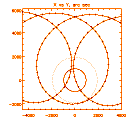 |
 |
By now Yohkoh SXT is a veteran observer of X-ray solar eclipses. We have written several previous science nuggets on earlier ones, for example the eclipse of February 26, 1998. As usual, we have obtained a detailed calculation of the lunar position as viewed from Yohkoh from M. Soma of the National Astronomical Observatory (Mitaka, Tokyo, Japan). The following plots show the predictions based on orbital elements of July 13, 1999. We may be able to update the plots shown here with new elements obtained closer to the time of the eclipse. For information regarding the eclipse as viewed on the surface of the Earth, please see the NASA eclipse pages which have abundant information. As usual, Yohkoh will see several episodes of eclipse. The Moon executes a looping motion, counterclockwise in sense on our standard view (E to the left), and progressing from west to east. Because the path of totality lies in Europe, it's visible during the northerly swings of the Yohkoh orbit: The TRACE plot, on the right, is interestingly different because TRACE is in a polar orbit.
 |
 |
On the plot above (click to enlarge) we show the lunar location every two minutes (during sunlit portions of the Yohkoh orbit). The smaller circle in the center represents the Sun, with the larger circle at the sum of the solar and lumar radii; thus whenever the asterisks fall inside this larger circle, there's a partial eclipse as viewed by Yohkoh.
The plot below shows the same information on a somewhat less confusing diagram, namely a plot of Sun-Moon separation as a function of time. We see the same two partial eclipses and two "kisses" where the Moon will just occult part of the corona up to the solar limb.
Fortuitously, we find ourselves 27 days from the eclipse at the time of writing. Thus the Yohkoh images below
shows our best guess about the coronal configuration at the time of the eclipse, unless the brave theorists Mikic and Linker make another model prediction. This image shows the Sun in its lowest state of activity since late April. We see an exquisite sigmoidal interconnecting loop structure between two active regions in the SE quadrant. Also there is a huge polar-crown filament channel in the SW - it will be interesting to see if it is still there in August, supporting a mammoth helmet streamer to be admired by the eclipse-viewers strung out from Lands End to Hyderabad.
H. Hudson 15-Jul-99
Note added 9-Aug-99: the Yohkoh eclipse calculations shown in the plots above have been updted using the current orbital elements.
Note added 11-Aug-99: the right image above is from one day before the eclipse. Note that the large interconnecting sigmoidal structure in the SW is still there! Our greybeards are pondering this remarkable persistence of a stressed large-scale field pattern.